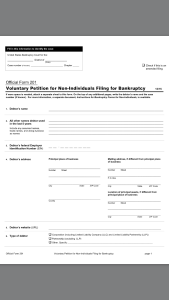
When an insolvent entity files for bankruptcy, it can be tough to be a creditor. But holding equity — stock in a corporation or a membership interest in an LLC, a limited liability company — can be even worse. Under bankruptcy’s “absolute priority rule,” creditors generally must be paid in full before equity gets anything. That usually means that holders of equity, or claims treated as equity, get nothing.
Section 510(b) Mandatory Subordination. A recent decision by the U.S. Court of Appeals for the Ninth Circuit in In re Tristar Esperanza Properties, LLC serves as a good reminder of the special bankruptcy rules involving mandatory subordination of certain equity-like claims. More on the Tristar case in a minute, but first let’s take a look at the provision that spells out the mandatory subordination rule. Section 510(b) of the Bankruptcy Code provides:
For the purpose of distribution under this title, a claim arising from rescission of a purchase or sale of a security of the debtor or of an affiliate of the debtor, for damages arising from the purchase or sale of such a security, or for reimbursement or contribution allowed under section 502 on account of such a claim, shall be subordinated to all claims or interests that are senior to or equal the claim or interest represented by such security, except that if such security is common stock, such claim has the same priority as common stock.
Whole Categories Of Claims Subordinated. Unlike equitable subordination of claims under Section 510(c) of the Bankruptcy Code, which the bankruptcy court may impose if the specific circumstances merit it, Section 510(b) subordination is mandatory and applies to entire categories of claims. These include securities fraud or rescission claims, whether individually or as part of a class action, against the bankrupt company arising from the purchase or sale of its stock or other security.
- A securities fraud claim by current or former stockholders alleging fraud in the purchase of common stock, leading to damages when the stock price dropped? Subordinated to the level of common stock.
- A lawsuit for damages to stockholders for breach of an agreement to register or issue shares of common stock? Subordinated to the level of common stock.
- A lawsuit seeking to rescind a purchase of common stock, and get back the purchase price, due to alleged fraud? Subordinated to the level of common stock.
- A judgment in any of those cases against the issuer of the stock? You guessed it — subordinated to the level of common stock.
Why Are These Claims Subordinated? Congress enacted Bankruptcy Code Section 510(b), as one court said, “to prevent disappointed shareholders . . . from recouping their investment in parity with unsecured creditors.” Put another way, Section 510(b) ensures that claims of true creditors are not diluted by claims of stockholders or former stockholders seeking damages arising from their stock interests.
- As the old saying goes, creditors just want to get paid. Stockholders, on the other hand, invest risk capital in hopes of sharing in a company’s profits and “upside” potential. With that chance, however, comes the risk of losing their equity investment.
- If claims arising out of the purchase or sale of securities were not subordinated, creditors would recover less and shareholders (or former shareholders) would effectively be paid on the same level as creditors, not below them as the absolute priority rule dictates.
- To avoid this outcome, the Bankruptcy Code imposes mandatory subordination on these types of equity-related claims, preventing shareholders from transforming an equity-like claim into a judgment or proof of claim entitled to creditor treatment in bankruptcy.
- As a side note, mandatory subordination is similar in concept but nevertheless different from recharacterization of a debt as equity, which involves an analysis on a case by case, rather than category, basis.
Subordination Only As To The Bankrupt Entity. The fact that these claims are subject to mandatory subordination in a bankruptcy of the issuer or its affiliate does not mean that securities fraud or other claims will be subordinated against third parties, including underwriters or directors and officers, or that insurance proceeds might not still be available to settle those claims. However, once an issuer files bankruptcy, claims against its assets in the bankruptcy estate will face mandatory subordination.
Are There Any Exceptions? Lower courts have held that mandatory subordination does not apply to convertible promissory notes where the conversion feature was never invoked, or to an “old and cold” promissory note for an equity repurchase made many years before the bankruptcy (although in the Tristar decision the Ninth Circuit noted that it was not reaching that issue). The Ninth Circuit held in In re American Wagering, Inc., 493 F.3d 1067 (9th Cir. 2007), that a claim under an employment agreement, where the claimant was never an equity investor and compensation was simply calculated based on the price of stock, should not be subordinated under Section 510(b). Depending on the circumstances, particular claims might be subject to an equitable subordination challenge under Section 510(c) of the Bankruptcy Code but, as noted, that is a separate legal standard and analysis.
The Tristar Esperanza Properties Decision. On April 2, 2015, the U.S. Court of Appeals for the Ninth Circuit issued a 12-page decision in In re Tristar Esperanza Properties affirming the lower courts’ decisions to subordinate under Section 510(b) a money judgment in favor of Jane O’Donnell, a member of the LLC. O’Donnell had exercised her right to withdraw from the LLC and require Tristar to purchase her membership interest based on the valuation procedure in the LLC operating agreement. She and Tristar could not agree on a valuation, and O’Donnell brought an arbitration action, receiving a $410,000 award in her favor. When Tristar failed to pay she confirmed the arbitration award in state court and got a state court judgment.
- Less than a year later Tristar filed a Chapter 11 bankruptcy case, and O’Donnell filed a proof of claim based on the state court judgment.
- Tristar filed an adversary proceeding seeking to subordinate her claim under Section 510(b), among other challenges. The bankruptcy court granted Tristar summary judgment and the Bankruptcy Appellate Panel affirmed.
- On appeal to the Ninth Circuit, O’Donnell’s main arguments were that although her LLC membership interest was a security of the debtor, her claim was neither for “damages” nor “arising from the purchase or sale” of the membership interest.
- The Ninth Circuit rejected both arguments, interpreting both clauses of Section 510(b) broadly.
- First, it held that her claim was for “damages,” in this case for breach of contract, and Section 510(b)’s damages clause should be read broadly. It rejected her argument that fixed, admitted debts should be excluded from the scope of “damages” in Section 510(b), noting that the very broad definition of “claim” in Section 101(5)(A) of the Bankruptcy Code makes no such distinction.
- Second, even though O’Donnell was a judgment creditor and no longer an equity holder at the time Tristar filed bankruptcy, the Ninth Circuit emphasized that Section 510(b) applies if a creditor claim “arises from the purchase or sale of a security.” A claim will be subordinated if there is a sufficient nexus or causal relationship between the claim and the purchase or sale of securities.
The Ninth Circuit’s Rationale. The Ninth Circuit elaborated on the rationale for mandatory subordination, quoting from its earlier decision in In re Betacom of Phx., Inc., 240 F.3d 823 (9th Cir. 2001) and explaining:
Our straightforward reading of the ‘arises from’ language in § 510(b) comports with congressional intent. As we have said, ‘[t]here are two main rationales for mandatory subordination: 1) the dissimilar risk and return expectations of shareholders and creditors; and 2) the reliance of creditors on the equity cushion provided by shareholder investment.’ Although O’Donnell did not enjoy the benefits of equity ownership on the date of the petition, she bargained for an equity position and thus embraced the risks that position entails.
Conclusion. The Ninth Circuit is essentially telling investors “once a shareholder, always a shareholder,” at least if a claim in bankruptcy arises from an equity interest. Even though O’Donnell had transformed her LLC membership interest into a money judgment, it was still subordinated and treated like equity. This new decision reminds us once again that Section 510(b)’s mandatory subordination rules impact entire categories of claims and make it extremely difficult to collect on any equity-like claim in bankruptcy.
Image Courtesy of Flickr by Ervins Strauhmanis





